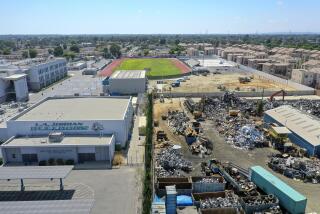Methane Gas Worries Persist in Oceanside
OCEANSIDE — Every so often an alarm light goes on in a classroom or corridor of one of three schools clustered on the edge of an old city dump off Mission Avenue. School officials, alerted by a central alarm bell, spring into action to track down the source of the problem signaled by the sophisticated detection system.
The alert often is caused by a can of cleaning solvent carelessly left open or by an unlighted pilot light on one of the schools’ cooking class stoves. But the danger always exists that it is methane gas seeping up from the slowly decaying garbage.
When the central alarm at Jefferson Junior High went off recently and refused to be quieted, officials thought they had an explosive situation on their hands--an invasion of the odorless, invisible methane. But it was determined that the alarm device was defective and needed to be replaced.
Causing the emotional stress at Jefferson, Mission Elementary and Clair Burgener School for the Handicapped is the knowledge that, just a few yards away and a few feet underground, there are gases that could ignite or cause an explosion if the right set of unlucky circumstances occurred.
Well No. 17 serves as a reminder to administrators, teachers and pupils of the presence of their noxious neighbor. The maverick well, only a few feet from the foundation of the Jefferson boys’ locker room, is unlike the 39 other wells on the former landfill--it consistently registers relatively dangerous levels of methane.
In the first tests of the new school year, No. 17 registered 28% methane concentration at a 5-foot depth. Concentrations of 5% or more are capable of burning or causing an explosion if confined in an enclosed space.
Dan Armstrong, spokesman for the Oceanside Unified School District, said a school committee will meet Monday to discuss the methane and the stress that has built among teachers and students since the dump was closed and capped in January, 1981, turning it from a noisy, smelly neighbor into a silent, deadly menace.
School officials also have asked Oceanside city officials to take action to remedy the seepage registered by No. 17, possibly by digging additional wells to drain off the gas from a decade’s accumulation of garbage and sludge.
The wells, installed after methane gas was discovered seeping into school grounds and even into buildings in 1981, are designed as part of a disposal system that sucks the gas from the depths of the dump through lateral pipes to a burning room for disposal.
The alarm systems are to be inspected today and Friday by the Denver firm that installed them, and engineers who installed the gas retrieval system will meet with city officials to discuss cures for Well No. 17.
More to Read
Sign up for Essential California
The most important California stories and recommendations in your inbox every morning.
You may occasionally receive promotional content from the Los Angeles Times.










